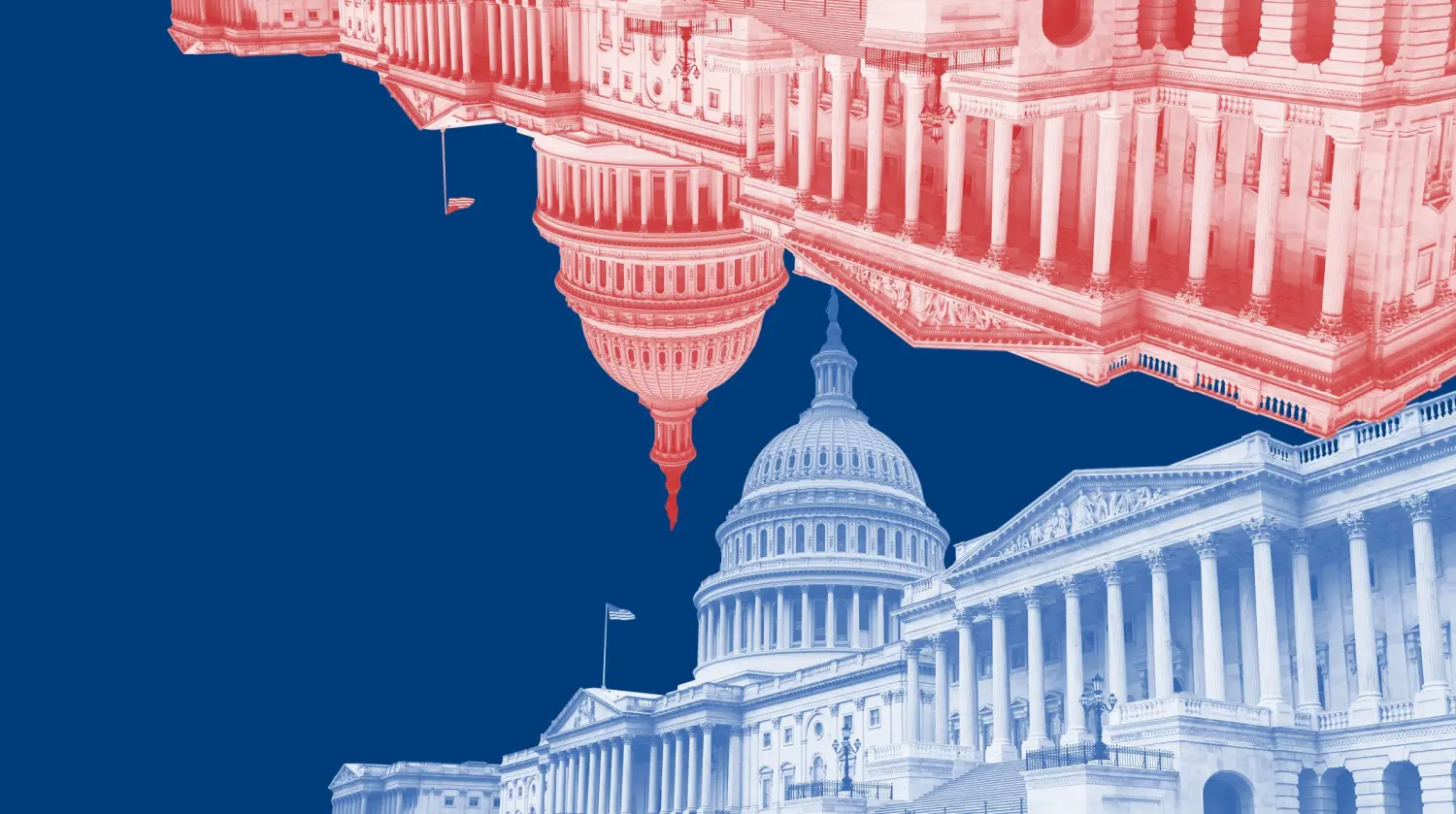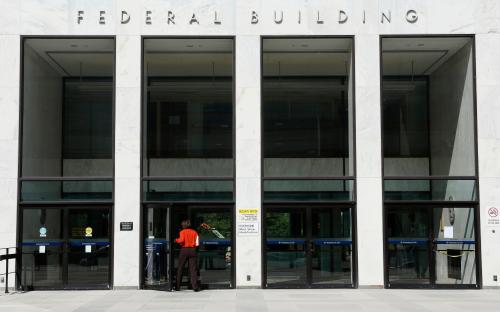This post is part of a series on the need for government reform and how to get it done. For more on this topic, visit the series page.
President Barack Obama entered office with the Great Recession raging and the true size of the federal workforce at about 10 million civil servants, postal workers, active duty military, contractors, and grantees. He raised the total with billions in economic stimulus to 11.3 million, then backed it down to about 9 million before leaving office. With the economy in full-throated rebound, Obama gave Donald Trump the rare opportunity to rebalance the federal government’s blended workforce.
Despite campaign promises to the contrary, Trump opened the contract and grant spigots instead, adding more than 2 million jobs to the blended federal workforce, including 1 million in the Departments of Defense, Transportation, and Health and Human Services alone.
Figure 1 shows the rise, fall, and rise again of the true size of government.[1] Despite Trump’s recent claim that the Pentagon brass was responsible for keeping the military-industrial complex “happy,” he has rarely missed an opportunity to celebrate his commitment to increased spending. According to a recent Washington Post analysis, under Trump’s tenure, the defense budget will have grown almost 30 percent by end of the 2021 fiscal year, even as estimated defense contract employment has surged by 20 percent. Although the Pentagon has been a grateful partner in the run-up, Trump has been front and center in keeping the defense industry happy.
The Trump administration would likely argue that the blended workforce is essential to national security and economic growth—gone are the days, they might say, where federal arsenals could make weapons of war. The Trump administration might also add that America has relied on a mix of federal, contract, and grant employees to faithfully execute the laws since its first breath of independence in 1776. They even might note that contract and grant workforces are “at-will” employees of a kind who disappear when the contracts and grants end, although that would belie the reality of large corporations that are highly dependent on federal contracts for their survival.
Despite its role in delivering on the government’s promises, the federal government’s blended workforce may have become a threat to the very delivery it guarantees. Convinced that the contract workforce was overpaid and guilty of “outright fraud” and “delay after delay after delay after delay,” Obama outlined a new insourcing process for bringing “inherently-governmental” jobs back into the federal inventory.
He started in March 2009 by ordering the Defense Department to examine its contract workforce and ask whether the jobs would cost less and be better performed in-house and continued with Office of Management and Budget taskforce on “managing the multi-sector workforce.” Although the effort was soon abandoned as the defense industry marshalled its substantial lobbying power in opposition, the basic question of who should do what and for how much remains unanswered a decade later.[2] The next president must do better, if only because the world has become so complex and the war for talent so intense that Congress and presidents can no longer be sure that the right employees from the right sectors are in the right jobs at the right time at the right price and with the right skills.
The next president must also ask whether the blending has unleashed the same forces that led President Dwight D. Eisenhower to warn of the military-industrial complex and its “acquisition of unwarranted influence, whether sought or unsought.” His warning focused on the “vast conjunction” of the armed services and the arms industry, but are equally relevant for the six federal-industrial complexes shown in Figure 2. Eisenhower’s military-industrial complex occupies 52 percent of the space in the figure, but the other five federal-industrial complexes have a significant influence in their own right.[3]
The true size of the blended workforce is driven by a mix of demographic, bureaucratic, and political pressures that give contract- and grant-funded employees a faster hiring process, greater opportunities for advancement, greater responsibility earlier in career, access to further training and education, and insulation from executive-level tirades, retirement cuts, and political interference. It is no surprise that federal employees trail private-sector employees on almost every measure of their work, including having sufficient resources to get their job done (-24%); saying their talents are well-used in the workplace (-19); they are satisfied with their jobs (-17%) and with their involvement in decisions that affect their work (-16%); are recognized for providing high-quality products and services (-15%); believe employees are encouraged to come up with new and better ways of doing things (-14 %) and have trust and confidence in their supervisors (-13%).[4]
These pressures toward private- and grant-funded employees pale when compared to the biggest driver of all: the long-standing pressure to hold federal employment at or below 2 million. The cap was originally authored by Rep. Jamie Whitten (D-MS) in 1950 in an effort to limit spending as the Korean War roared. Called before the House Post Office Committee to explain his reasoning in 1954, Whitten said he had no ax to grind and might have won an award if he had just asked for a regular count and let the totals create the pressure. “I thought 2 million permanent folks out to be enough to have on a permanent basis,” he explained. “So what I did was fix appropriately 2 million as all the permanents we are going to have.”
Casually established though it was, the amendment continues to work its will even after its repeal not once, but twice in the 1960s. Presidents and Congresses were more than willing to take a stand against big government through dozens of caps, ceilings, and freezes, including Trump’s recording-breaking 2017 budget freeze, but they could not find a way to count the contract and grant workforce. Viewed side-by-side, Figures 1 and 4 show the long-term effect of Whitten’s cap—steady federal employment over the years and wild swings across the contract and grant workforce.[5]
The federal government will never break Whitten’s grip until Congress and the president develop a system for counting heads. In a political system where even small increases in the number of federal employees can trigger public outrage, the lack of parallel data on contract and grant employees undermines the thoughtful allocation of labor needed to ensure faithful execution of the laws. That was not Whitten’s intent, but it is easy to spot in too many federal breakdowns.
[1] The estimates of contact and grant employment were produced through a methodology designed by Eagle Eye Publishers in the early 2000s and refined Nation Analytics in the two most recent iterations of the approach. The estimates of growth come from federal government inventories of contract and grant spending. Each purchase carries a Northern American Industrial Classification (NAICS) code that provides detailed information on what was purchased and in what amount. This data is then analyzed using the U.S. Bureau of Economic Affairs RIMS III input/output model of the U.S. economy to determine the number of direct (prime), indirect (sub), and employment created the spending associated with each contract or grant. This analysis only includes direct and indirect spending. Although induced spending is one goal of federal stimulus spending, the jobs created are not directly accountable to the government. Appendix Table 1 provides the estimates of the true size of government, while Appendix Table 4 shows the source of gains among the departments that grew the most between 2017-2020. I am particularly grateful to Nick Taborek for his wise counsel and analysis in helping me extend my trend lines from previous periods.
APPENDIX TABLE 1: THE SOURCES OF GROWTH, 2017-2020
|
2017 (In thousands) |
2020 (In thousands) |
FTE Change (In thousands) |
% Gain/ | Source of Growth | |
| 1. Defense | 3258 | 3869 | 611 | 19% | Contracts |
| 2. Transportation | 632 | 897 | 265 | 42% | Grants |
| 3. HHS | 636 | 828 | 192 | 30% | Grants |
| 4. Veterans | 624 | 709 | 85 | 14% | Grants |
| 5. Homeland | 390 | 489 | 99 | 25% | Grants |
| 6. Energy | 354 | 367 | 13 | 4% | Mix |
| 7. Agriculture | 160 | 197 | 37 | 23% | Grants |
| 8. Interior | 120 | 165 | 45 | 38% | Grants |
| 9. Treasury | 137 | 155 | 18 | 13% | Civil Service |
| 10. NASA | 134 | 151 | 17 | 13% | Mix |
| 11. Commerce | 105 | 134 | 29 | 28% | Mix |
[2] For further details on this battle, See Paul C. Light, The Government Industrial Complex: The True Size of the Federal Government, 1984-2018, New York, NY; Oxford University Press, 2019, chapter 4.
[3] The domestic/industrial complex is composed of the departments of Agriculture, Education, Health and Human Services, Housing and Urban Development, Justice, Transportation, and NASA; the diplomatic/industrial complex is composed of the State Department and USAID; the Economic/Industrial complex is composed of the departments of Commerce, Treasury, Labor, and the Social Security Administration, the homeland/industrial complex is composed solely of the Department of Homeland Security only; and the environment/industrial complex is composed of the Energy and Interior departments and the Environmental Protection Agency.
[4] These figures come from The Partnership for Public Service, “Overall Findings and Private Sector Comparison, 2019.” available at https://bestplacestowork.org/analysis/. The federal findings were based on answers from 615,000 federal employees surveyed by the U.S. Office of Personnel Management, while the private sector findings were based on a Mercer/Sirota database that consists of data from 6,450,000 respondents over five years (2014-2018).
[5] Paul C. Light, The Government-Industrial Complex: Tracking the True Size of Government, 1984–2018, (New York: Oxford University Press, 2018), published in conjunction with the Volcker Alliance.
The Brookings Institution is committed to quality, independence, and impact.
We are supported by a diverse array of funders. In line with our values and policies, each Brookings publication represents the sole views of its author(s).









Commentary
The true size of government is nearing a record high
October 7, 2020